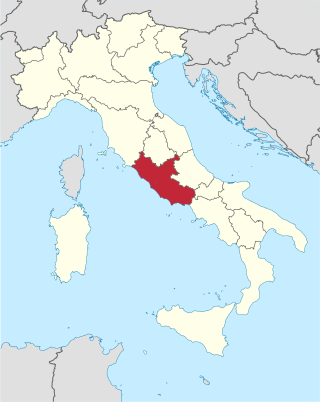
Lazio or Latium is one of the 20 administrative regions of Italy. Situated in the central peninsular section of the country, it has 5,714,882 inhabitants and a GDP of more than €197 billion per year, making it the country's second most populated region and second largest regional economy after Lombardy. The capital of Lazio is Rome, which is also the capital and largest city of Italy.

The provinces of Italy are the second-level administrative divisions of the Italian Republic, on an intermediate level between a municipality and a region. Since 2015, provinces have been classified as "institutional bodies of second level".
Frosinone is a comune (municipality) in the Italian region of Lazio, administrative seat of the province of Frosinone. It is located about 75 kilometres (47 mi) southeast of Rome, close to the Rome-Naples A1 Motorway. The city is the main city of the Valle Latina, an Italian geographical and historical region that extends from south of Rome to Cassino.

The province of Ravenna is a province in the Emilia-Romagna region of Italy. Its capital is the city of Ravenna. As of 2015, it has a population of 391,997 inhabitants over an area of 1,859.44 square kilometres (717.93 sq mi), giving it a population density of 210.81 inhabitants per square kilometre. Its provincial president is Claudio Casadio.

The province of Terni is the smaller of the two provinces in the Umbria region of Italy, comprising one-third of both the area and population of the region. Its capital is the city of Terni. The province came into being in 1927, when it was carved out of the original unitary province of Umbria.
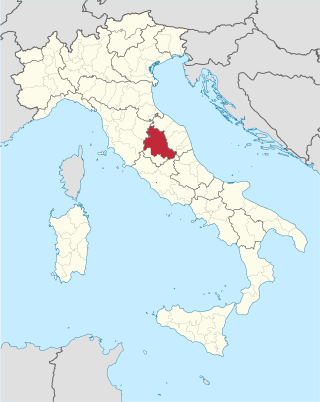
The province of Perugia is the larger of the two provinces in the Umbria region of Italy, comprising two-thirds of both the area and population of the region. Its capital is the city of Perugia. The province covered all of Umbria until 1927, when the province of Terni was carved out of its southern third. The province of Perugia has an area of 6,334 km2 covering two-thirds of Umbria, and a total population of about 660,000. There are 59 comuni in the province. The province has numerous tourist attractions, especially artistic and historical ones, and is home to the Lake Trasimeno, the largest lake of Central Italy. It is historically the ancestral origin of the Umbri, while later it was a Roman province and then part of the Papal States until the late 19th century.

Between the Congress of Vienna (1815) and the capture of Rome (1870), the Papal State was subdivided geographically into 17 apostolic delegations for administrative purposes. These were instituted by Pope Pius VII in a motu proprio of 6 July 1816: "Quando per ammirabile disposizione".

Rome was a department of the First French Empire in present-day Italy. Its principal city was Rome. It was formed on 17 May 1809, when the Papal States were annexed by France, and was first known as the Département du Tibre before being renamed on 17 February 1810. Following the conquest of the Eternal City, Napoleon granted to his son Napoleon II the title of the King of Rome.
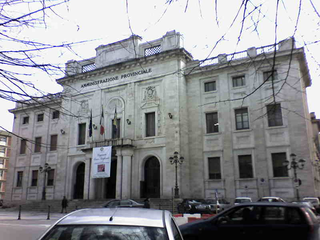
The province of Frosinone is a province in the Lazio region of Italy. Its capital is the city of Frosinone. It has an area of 3,247 square kilometres (1,254 sq mi) and a total population of 493,605 (2016). The province contains 91 comuni, listed in the comuni of the province of Frosinone.

The province of Latina is a province in the Lazio region of Italy. Its provincial capital is the city of Latina. It is bordered by the provinces of Frosinone to the northeast and by the Metropolitan City of Rome Capital to the northwest.

The province of Rieti is a province in the Lazio region of Italy. Its capital is the city of Rieti. Established in 1927, it has an area of 2,750.52 square kilometres (1,061.98 sq mi) with a total population of 157,887 people as of 2017. There are 73 comuni in the province.
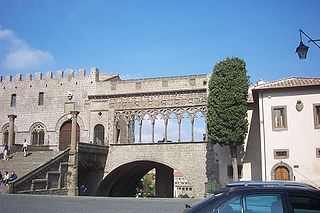
The province of Viterbo is a province in the Lazio region of Italy. Its capital is the city of Viterbo.
Lazio is a region in central Italy that includes the city and province of Rome and the other provinces of Frosinone, Latina, Rieti, and Viterbo. Generally speaking, the Lazio Symphony, which has its base in Rome, itself, "plays the provinces," so to speak, and puts on regular concerts throughout Latium. Other than that, the provinces offer:
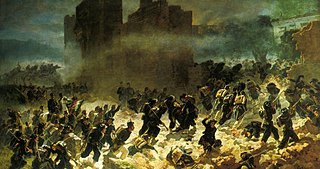
The Capture of Rome on September 20, 1870, was the final event of the unification of Italy (Risorgimento), marking both the final defeat of the Papal States under Pope Pius IX and the unification of most of the Italian Peninsula under the Kingdom of Italy, a constitutional monarchy.

The Diocese of Rome, also called the Vicariate of Rome, is a Latin diocese of the Catholic Church under the direct jurisdiction of the Pope, who is Bishop of Rome and hence the supreme pontiff and head of the worldwide Catholic Church. As the Holy See, the papacy is a sovereign entity with diplomatic relations, and civil jurisdiction over the Vatican City State located geographically within Rome. The Diocese of Rome is the metropolitan diocese of the province of Rome, an ecclesiastical province in Italy. According to Catholic tradition, the first bishop of Rome was Saint Peter in the first century. The incumbent since 13 March 2013 is Pope Francis.

Municipio I is an administrative subdivision of the municipality of Rome, encompassing the centre of the city.

The Campagna and Marittima Province was one of the seven provinces of the Papal States from the 12th century to the end of the 18th.

The flag of Lazio is one of the symbols of the region of Lazio, Italy. The flag is currently only de facto official, but is in common use.























